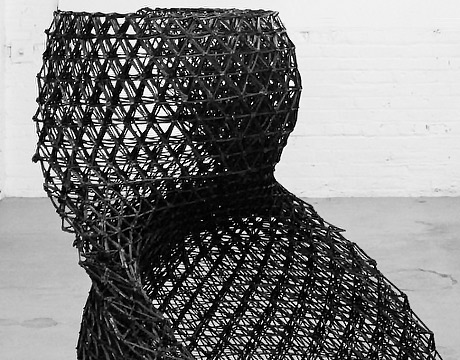3D Printer’s Twist May Shape Homebuilding
3D Printer’s Twist May Shape Homebuilding


Freeform 3D printing can change the future of building. Image: Branch Technology
Moving along a 33-foot-long rail, a large, industrial-scale robot works with a 3D printer to extrude plastic and carbon-fiber that forms an intricate lattice that will become the core of a wall, a task that may open home building and other structures to new and cheaper construction methods.
The rapid development of 3D printing, digital, and additive manufacturing now reaches across industries and disciplines, producing new applications and products on a seemingly regular basis. One of the latest is in construction, where one startup architectural firm wants to take the bulk out of structures with its novel 3D-printed wall core. It expects in 2017 to begin building a house using completely 3D-printed components from the design chosen in a competition to prove the concept.
Platt Boyd, an architect and founder of Chattanooga-based Branch Technology, developed what he calls C-Fab, for the Cellular Fabrication 3D printing platform. There are other large-scale 3D printers being used to build buildings, but they are bulky, operating from gantry cranes to place layers of heavy concrete. Boyd’s idea is to use a 3D printer to form lightweight wall cores of a carbon fiber-reinforced plastic matrix that can be used with standard building components such as outside cladding or inside drywall to reduce weight, increase productivity and lower costs.
“Construction is twenty percent less productive than it was twenty years ago,” says Boyd. “Most other industries are up 140 percent in that time.” Branch’s printer, a customized 12.5-ft Kuka robotic arm, is large; at 25 feet wide and 58 feet long, it claims to be the world’s largest freeform 3D printer. By giving the robot mobility to move along the rail, the printer works in open space as opposed to a restricted area utilized by printers fitted to gantry cranes. Further, algorithims written by Boyd and the Branch team allow it to build freeform structures based on almost any geometry the designer has used in CAD, says Boyd.
Although lightweight, the lattice boasts a 3000:1 strength ratio. A small-scale matrix weighing 28 ounces and filled with springfoam held 3,000 pounds, says Boyd. He says it is three times stronger than wood framing and will “enable mass customization” in building components. He expects savings of up to 50 percent in materials to make an object and 50 percent of energy costs used in traditional manufacturing.
Prior to founding Branch, Boyd worked as an architect in Montgomery, AL. But he was searching for a more natural form of building, and was intrigued by 3D printing. But those using 3D printing in building were using single materials in layers that were built up. Most buildings, says Boyd, are built using many systems that form a composite whole.
I was thinking of 3D printing lattices as a scaffold that can be used with other construction materials.
Platt Boyd, Branch Technology
“I was thinking of 3D printing lattices as a scaffold that can be used with other construction materials,” he says. Rather than maximize 3D printing, he wants to minimize 3D printed components and pair them with traditional materials that then can be assembled or fitted together to make a complete structure.
Key to the process is looking at how structures are made at the cellular level, says Boyd. To gain insight, he looked at the cellular foundation of natural structures such as the human femur, the thigh bone and strongest bone in the human body. “The material filling the cell provides the strength,” he says. “So we have to translate that mindset to constructing a building.”
Using Branch Technology’s algorithms, designers can optimize geometries during direct digital manufacturing to customize building components, or rather their original support structure. Those structures are then filled out with standard building components.
The firm has already demonstrated a single wall using the 3D printed lattice and filled with sprayfoam is 1.3 times stronger than a wood stud wall. Once fitted out with concrete, Boyd and colleagues determined it had the same strength as a traditional concrete wall. The lattices are also very light; two people can easily carry a standard wall lattice without concrete. A 1.5 pound plastic wall can support 1,500 pounds, says Boyd, and a 2.5-pound segment fitted with concrete can support just shy of 3,000 pounds. Because the lattice core is hollow, it uses a lot less material than a standard wall, reducing material costs and waste.
Branch Technology got a boost from the nearby U.S. Department of Energy’s Oak Ridge National Laboratory, which has been working with Local Motors to use 3D printing to build cars and Cincinnati Inc. to develop the Big Area Additive Manufacturing machine. ORNL supplied Branch with its carbon-reinforced plastic, but the material proved brittle and had to be further refined to a composition of 95 percent ABS plastic and 5 percent carbon fibers.
To further prove their system, Branch sponsored a design competition where anyone could submit CAD models for a 600 to 800 square meter house that would be constructed using C-Fab to rethink traditional architecture, ergonomics, construction and building systems. The winning team from WATG Urban Architecture Studio was chosen earlier this year from worldwide entries. Called the world’s first freeform 3D printed house, WATG named its submission “Curve Appeal.” It consists of an exterior skin and interior core, “derived from simple, yet careful calculated archways that ultimately blends with the site leaving an organic presence,” according to WATG.
Before construction begins in 2017, Boyd and colleagues must push their system and products through testing to meet structural standards of the International Code Council. “We have to get through engineering and testing before printing,” says Boyd.
Until now, Branch has been printing nonstructural interior items and freestanding sculptures. But they now are also working with the structural engineering department of Massachusetts Institute of Technology on 3D-printed beams.
“We’re about to try to print a structurally optimized beam,” says Caitlin Mueller, an assistant professor in the Building Technologies Program. She leads the Digital Structures Research Group and is co-director of the Structural Design Lab. “We’ve been interested in 3D printing, as an alternative to layer-by-layer. It saves material, allows for complexity in design. This is really exciting.”
Learn more about the latest technologies in 3D printing at ASME’sAM3D Conference & Expo.





